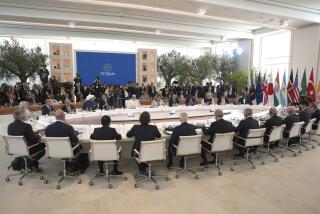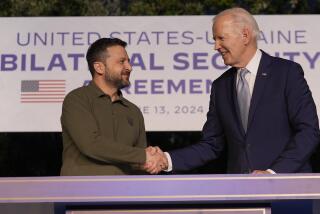Analysis : Talks Provide Momentum for ‘New Era’ in Relations
MOSCOW — No major new agreements were signed and progress on arms control was incremental, but the fourth summit meeting between President Reagan and Soviet leader Mikhail S. Gorbachev established a pattern for careful, sustained negotiations that could yield major dividends.
Indeed, the process--which began with the first Reagan-Gorbachev summit in Geneva in 1985--produced significant advances on human rights and regional issues during the four-day summit that ended Wednesday.
And even if the lack of a breakthrough on strategic arms reduction means a treaty is unlikely to be completed before Reagan leaves office next January, the two sides’ deepening commitment to such an accord still will give new momentum to the negotiations.
“I would hope that before the year is out, we could eliminate the differences that still exist” on START, the acronym for the strategic arms reduction talks, Reagan said at an end-of-summit news conference here. “But if not, I would hope that my successor would continue, because here we are getting at the most important reduction that should take place in nuclear weapons.”
Sense of Urgency
That sense of urgency was echoed by a senior U.S. official close to the detailed negotiations:
“We’ve learned, on both sides, that we can’t afford any hiatus in the arms control process any more. Things move too fast in weapons technology. We’ll go to the end (of the Administration) and turn over all the drafts to the next guys (in the new Administration) so they can pick up the ball very quickly.”
Underlying the determination to press ahead was a sense not only that the issue was urgent but that the pattern of realistic, concrete, achievement-oriented negotiations established between Reagan and Gorbachev had opened the way for a potentially bright “new era” in U.S.-Soviet relations.
Gorbachev, while complaining about “missed chances” and stopping “halfway” on some issues this week, emphasized the fruits of continuity in the intense political dialogues of four summits in three years.
“The meetings have been freed of propaganda gambits and demarches” of the past, he said.
Asked if regular summits are necessary to complete the work, he replied impatiently: “Vitally necessary”--Gorbachev’s shortest answer in a post-summit news conference that ran for two hours.
On strategic arms control, the slow pace now set for negotiations in Geneva--the recessed talks will not resume until July 12--is a strong confirmation of the pessimistic outlook for START in this Administration. But the arms talks will continue to the end of the Administration, instead of breaking off to await the election of a new President.
Differences between the United States and the Soviet Union “continue to recede” across the board, Reagan declared. Negotiations over the past three years have achieved “progress across the broad agenda” of human rights, regional conflicts and arms control, he said.
Soviet Change on Rights Issue
On human rights, despite Gorbachev’s irritation over Reagan’s meetings with dissidents here, U.S. officials said “a qualitative change” on Soviet attitudes toward the sensitive issue took place at this summit.
This breakthrough was reflected in the expanded language in the concluding joint statement. In previous summit communiques, a single sentence noted that “a thorough and candid discussion” took place on the subject.
In this communique, the human rights section, almost 10 times longer than last year, spoke of “increasingly broad and detailed” talks and the aim of “sustained, concrete progress” in order to “maximize assurances of rights, freedoms and human dignity of individuals.”
Reagan and Gorbachev discussed creation of a forum that would meet regularly to bring together a spectrum from each society, including exchanges between legislators, legal experts, doctors and representatives of other professions expert on rights issues.
In real terms, emigration levels for Jews and other national minorities have risen, several hundred political and religious prisoners have been released--with roughly an equal number still in jail--and the Soviets have promised to institutionalize reforms by changing laws and even amending their constitution.
Little Change on Regional Issues
On regional concerns, which are tension points in U.S.-Soviet relations, there was little change in communique language since last year’s Washington summit. But Gorbachev said “real possibilities appeared for solving” some Third World conflicts.
He cited “some drawing together of positions” in the Arab-Israeli dispute and said that Cambodia, which is occupied by about 100,000 Vietnamese troops, “lends itself to solution very soon.” Hanoi has announced it will pull out 50,000 men by the end of this year and the rest by 1990.
A senior U.S. official was almost as upbeat about prospects for movement on regional matters, although the emphasis was on southern Africa as the most promising area for progress.
The two sides, following new momentum in their peace efforts in that region, have now agreed to a target date of Sept. 29 for resolving outstanding differences concerning withdrawal of Cuban and South African forces from Angola and freedom for neighboring Namibia.
Setting this target date, the 10th anniversary of U.N. Resolution 435, which calls for South African withdrawal from Namibia and U.N.-monitored elections there, means “there is a shared U.S.-Soviet belief that the problem should be solved now,” the official said. The move was designed to provide an additional impetus to the peace process.
‘Different Assumptions’
While the two sides have some general principles in common about peace in the Mideast, they still diverge when they try to put the principles to work. In this area, “the two sides are still driven by different assumptions,” the official said.
The arms control advances came, as expected, in the easiest two of the four major problems standing in the way of a START agreement now. Progress was made on both mobile missiles and air-launched cruise missiles, but significant difficulties remain before these problems will be fully solved.
On mobile intercontinental ballistic missiles, the two sides resolved more than half of the issues. For example, they agreed to restrict both their road- and rail-mobile missiles to an agreed area until they are dispersed in a crisis.
But they have yet to agree on how large the restricted area should be: about 10 square miles, as the United States wants, or 40 square miles, as the Soviets proposed.
Similarly, on air-launched cruise missiles, they reduced 13 problems to five. But those remaining are the most difficult, such as how many such missiles to attribute to each bomber carrying the weapons, irrespective of the number they actually carry.
And they made no progress on the far more difficult issues of sea-launched cruise missiles and the anti-missile defense program called the Strategic Defense Initiative, or “Star Wars.”
More to Read
Sign up for Essential California
The most important California stories and recommendations in your inbox every morning.
You may occasionally receive promotional content from the Los Angeles Times.










